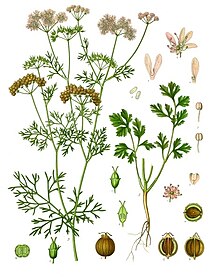Coriander
| Coriander or cilantro | |
|---|---|

| |
| Illustration of coriander parts | |
| Scientific classification | |
| Kingdom: | Plantae |
| Clade: | Tracheophytes |
| Clade: | Angiosperms |
| Clade: | Eudicots |
| Clade: | Asterids |
| Order: | Apiales |
| Family: | Apiaceae |
| Genus: | Coriandrum |
| Species: | C. sativum
|
| Binomial name | |
| Coriandrum sativum | |
Coriander (/ˌkɒriˈændər, ˈkɒriændər/;[1] Coriandrum sativum) is an annual herb in the family Apiaceae. It is also known as Chinese parsley, dhania or cilantro (/sɪˈlæntroʊ, -ˈlɑːn-/).[2] All parts of the plant are edible, but the fresh leaves and the dried seeds (as a spice) are the parts most traditionally used in cooking.
Most people perceive the taste of coriander leaves as a tart, lemon/lime taste, but to nearly a quarter of those surveyed, the leaves taste like dish soap, linked to a gene which detects some specific aldehydes that are also used as odorant substances in many soaps and detergents.[3]
Botanical description[]

Coriander is native to regions spanning from Southern Europe and Northern Africa to Southwestern Asia.
It is a soft plant growing to 50 cm (20 in) tall. The leaves are variable in shape, broadly lobed at the base of the plant, and slender and feathery higher on the flowering stems.
The flowers are borne in small umbels, white or very pale pink, asymmetrical, with the petals pointing away from the center of the umbel longer (5–6 mm or 3⁄16–1⁄4 in) than those pointing toward it (only 1–3 mm or 1⁄16–1⁄8 in long). The fruit is a globular, dry schizocarp 3–5 mm (1⁄8–3⁄16 in) in diameter. Pollen size is approximately 33 micrometres.[citation needed]
Etymology[]
First attested in English during the late 14th century, the word "coriander" derives from the Old French coriandre, which comes from Latin coriandrum,[4] in turn from Ancient Greek κορίαννον koríannon (or κορίανδρον koríandron),[5][6] possibly derived from or related to κόρις kóris (a bed bug),[7][8] and was given on account of its foetid, bed bug-like smell.[9]
The earliest attested form of the word is the Mycenaean Greek